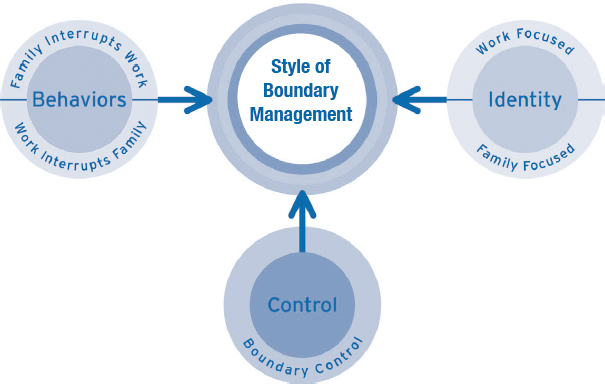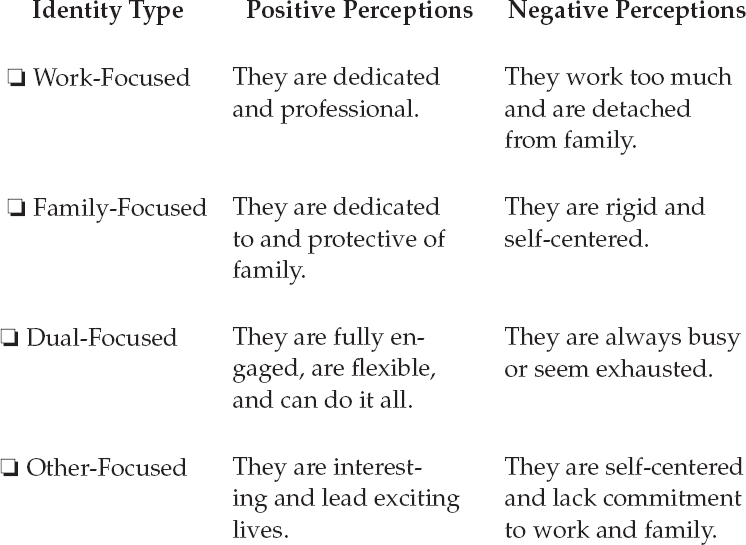A New Approach for Managing Work-Life Boundaries
What can you do to take advantage of connectivity without being overthrown by the disadvantages? The answer begins with how you aim to fulfill the responsibilities of your work and personal relationships.
There are three important concepts that can help you understand how you currently manage the boundaries between your work and personal life:
- Your behaviors: How do you manage work or family interruptions?
- Your identity: Where do you prefer to invest your time and energy?
- Your perceived control: How much control do you feel you have over how you fulfill your work- and family-related roles and responsibilities?

These three ideas support many different ways of managing the work-life boundary in response to the many different desires and ways that people have for handling work and personal time. In the following sections, you will learn about these diverse patterns. Additionally, you will find questions to use in considering how you manage work-life boundaries.
Behaviors
In general, people follow five basic behavioral patterns for organizing their work in the context of the rest of life:
No specific behavioral style is best for all individuals or across all situations. Each can elicit positive and negative perceptions in others. Exercise 1, Behavior, will help you determine which behavior style best fits your current work-life situation.
Identity
A second way of thinking about boundaries is in terms of identity. Your identity refers to how you see yourself and where you prefer to invest your time and energy. There are four identity types:
 |
Work-Focused individuals are career oriented and primarily invest themselves in their work. They prefer to give their best energy to their job-related activities. |
 |
Family-Focused individuals primarily identify with a family role. They prefer to invest most of their energy in being a parent, grandparent, spouse, or caregiver. |
 |
Dual-Focused individuals invest time and energy equally in both work and family. They prefer to structure their time so that they can give their best to both domains. |
 |
Other-Focused individuals prefer to invest their time and energy in life interests that do not directly relate to work or family. For example, they may prefer to invest in community volunteering or in their hobbies. |
Choose the behavior style that best describes you and also examine the associated perceptions others may have of your behavioral type. You can emphasize positive aspects of your behavioral style and manage negative perceptions to help others hold an accurate (and, one hopes, positive) view of your boundary-managing behavior.

Blurred boundaries can contribute to your well-being and the well-being of your organization and your family, but you must deal with trade-offs.
Exercise 2, Identity, will help you determine your identity type. As with the five behaviors, there is not one superior identity type. Additionally, there are positive and negative perceptions others associate with each identity type.
Exercise 2: Identity
Choose the description that most closely matches what you consider your primary identity. Examine the positive and negative perceptions others may have of your identity type.

Control
Control refers to your ability to decide when, where, and how to take care of work and family responsibilities. This is the third key factor in understanding your boundary-management style. There are three levels:
 |
High Boundary Control. People with a high degree of boundary control feel that they have a lot to say about how they divide their time and attention between work and family. They decide when to focus on work, when to focus on family, and when to integrate the two. They feel empowered to make decisions and to manage resulting trade-offs. |
 |
Midlevel Boundary Control. People with a moderate degree of control feel that they have some say in how they divide their time and attention between work and family. They sometimes decide when to focus on work, when to focus on family, and when to integrate the two. |
 |
Low Boundary Control. People with a low degree of control feel that they do not have much discretion over how they divide their time and attention between work and family. They may feel very constrained by their work schedule, family demands, or both. |
How would you describe your level of boundary control?
 High Boundary Control
High Boundary Control Midlevel Boundary Control
Midlevel Boundary Control Low Boundary Control
Low Boundary Control
With behavior and identity, there isn't one best approach, but it is better to have high or midlevel boundary control so that you feel in charge of your own schedule. This helps you meet the diverse (and often conflicting) needs or demands that you experience.




